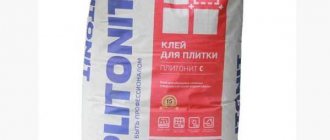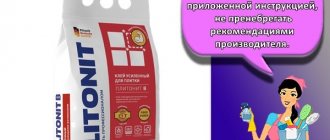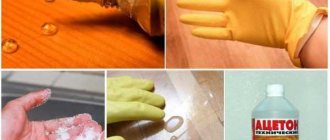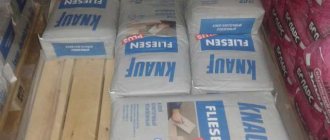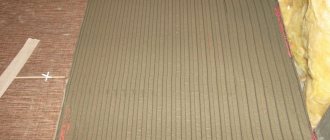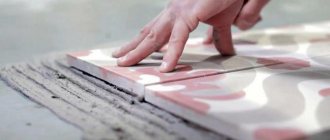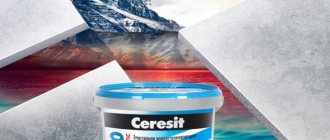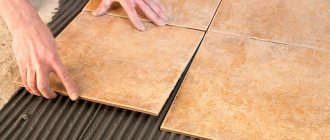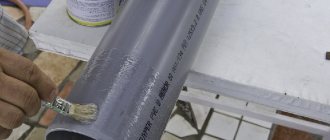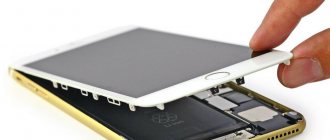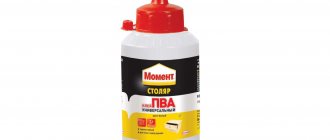Ceresit CM 17 adhesive is designed for fastening all types of tiles on difficult substrates for external and internal work. Since the glue is moisture-resistant and frost-resistant, it is suitable for laying tiles in a bathhouse. You can also use Diol D-307 glue.
Tile adhesive Ceresit CM 17
Properties
- highly elastic, resistant to deformation;
- has high adhesion;
- water- and frost-resistant;
- resistant to tile sliding;
- can be used on plasterboard and chipboard;
- ideal for swimming pools;
- ideal for heated screeds;
- suitable for laying large format tiles;
- suitable for indoor and outdoor use;
- Available in two versions - standard and with reduced dust formation (“Stop Dust”);
- environmentally friendly.
Features of Ceresit adhesives
One of the best manufacturers of cladding solutions is the Ceresit company.
In the process of finishing interior spaces with tiles, it is very important to use only high-quality adhesives. They must have good adhesion, water resistance and other characteristics. One of the best manufacturers of cladding solutions is Ceresit, which produces its products at the German Henkel plant.
A distinctive feature of Ceresit adhesive solutions is the environmental friendliness of the materials, which, even under the influence of temperature changes, do not emit harmful volatile chemicals into the atmosphere. Ceresit glue has the following technical parameters:
- environmental safety;
- excellent adhesion;
- high frost resistance;
- good moisture-repellent properties;
- resistance to slipping.
Markings on adhesive compositions indicate the technical features of the material, so below we will take a closer look at the most popular of them.
Application area
CM 17 adhesive is intended for fastening all types of mineral tiles - ceramic, porcelain stoneware, clinker, stone (except marble), etc., on walls and floors inside and outside buildings, mainly on complex and deformable bases and structural elements, such as:
- plasterboard, chipboard, gypsum board, OSB;
- plinths, parapets, entrance lobbies, balconies, terraces,
- exploited roofs;
- indoor and outdoor swimming pools;
- heated screeds inside and outside buildings;
- gypsum and anhydrite bases;
- rigid and elastic waterproofing coatings made from materials CR 65, CR 166 and CL 51;
- old tile cladding;
- durable, non-peeling paint coatings;
- lightweight and cellular concrete;
- “young” concrete at least 1 month old.
Due to its high elasticity, the adhesive prevents the occurrence of shear stresses between the tile and the base during deformation. Available in two versions - standard and with reduced dust formation (“Stop Dust”).
Ceresit SM-17
Ceresit cm-17 is quite often used for fixing large-caliber porcelain tiles.
Tile adhesive cm-117 differs from other types of mortars in its greatest elasticity. For this reason, the material is suitable for finishing mineral substrates both indoors and outdoors. It can be safely used for attaching tiles to plasterboard walls and ceilings. And thanks to its excellent frost resistance, Ceresit cm-17 tile adhesive is often used for fixing large-caliber porcelain tiles.
It is worth noting that the manufacturer produces two types of mixtures under the same label: regular and low-dust. Both tile adhesives Ceresit cm-17 have the following characteristics:
- Ability to withstand more than 150 freezing cycles;
- Low level of water absorption - no more than 2%;
- Resistant to temperature changes in the range from -50 to + 80 degrees;
- A fairly quick drying period - no more than 48 hours.
The price of a standard packaged product varies from 4.7 to 5.3 euros.
Preparing the base
The base must meet the requirements of SNiP 3.04.01-87 and have sufficient load-bearing capacity. Clean the base from dust, grease, bitumen and other substances that reduce the adhesion of the adhesive. Weak areas and peelings should be removed.
Irregularities up to 5 mm deep can be leveled with CM 17 glue at least 1 day before fixing the tiles. It is recommended to level out unevenness of more than 5 mm on walls with CT 24 or CT 29 plaster, and on floors with a suitable repair or flooring mixture.
Typical grounds:
- cement and cement-lime plasters, cement screeds (age ≥ 28 days, humidity ≤ 4%), concrete (age ≥ 3 months, humidity ≤ 4%), if necessary, prime with CT 17.
Atypical grounds:
- gypsum plasters (humidity ≤ 1%), anhydrite screeds (humidity ≤ 0.5%) should be sanded, dust-free and treated with CT 17 primer;
- plasterboard sheets fixed in accordance with the manufacturer's recommendations, chipboard and fiberboard (thickness ≥ 22 mm) should be treated with CT 17 primer;
- sand OSB boards (thickness ≥ 22 mm) with coarse sandpaper and remove dust;
- light and cellular concrete should be dust-free and treated twice with CT 17 primer;
- waterproofing coatings made from materials CR 65, CR 166 (age ≥ 3 days) and CL 51 (age ≥ 16 hours);
- wash and degrease old tile cladding;
- Sand acrylic paint coatings with coarse sandpaper and remove dust.
Ceresit SM-11
The most popular among consumers is considered to be the tile adhesive Ceresit cm-11.
The most popular among consumers is the tile adhesive Ceresit cm-11. It is used for finishing coatings made of brick, concrete, cement and lime surfaces. Due to its good qualities, the mortar mixture is used not only in residential but also in industrial premises with a special microclimate.
Ceresit cm-11 ceramic tile adhesive has the following advantages:
- high adhesion;
- frost resistance;
- moisture resistance.
A type of cement mixture of this brand is also the tile adhesive ceresit cm-11 plus, which is ideal for fixing not only ceramics, but also porcelain stoneware. The distinctive characteristics of the composition include:
- Low water absorption coefficient - no more than 3%;
- Possibility of use both indoors and outdoors;
- Resistance to temperature changes (withstands up to 100 freezing cycles);
- Short drying period - no more than 24-36 hours.
It is immediately worth noting that the elastic mortar used for finishing the floor is suitable for rooms with low mechanical load. Therefore, it is not recommended to be used for cladding flooring in public premises. The price for 1 bag of dry mixture weighing 25 kg varies from 2.9 to 3.5 euros.
Execution of work
To prepare the mixture, take a measured amount of clean water at a temperature from +1 5 to + 20 ° C. The dry mixture is gradually added to the water while stirring, achieving a homogeneous mass without lumps. Mixing is done with a mixer or drill with an attachment at a rotation speed of 400-800 rpm. Then a technological pause is maintained for about 5 minutes to allow the mixture to mature and mix again. The glue is applied to the base with a smooth spatula and the comb structure is profiled with a notched spatula. The size of the teeth is selected depending on the size of the tiles (see table).
If the cladding will be exposed to moisture and frost, as well as in the case of porcelain stoneware and stone tiles, it is recommended to additionally apply a continuous thin layer of adhesive to the mounting surface of the tiles (“combined fastening method”).
Do not soak the tiles! The tiles are laid on the glue and pressed no later than 25 minutes after its application, until the glue sticks to your hands. The position of the tiles can be adjusted within 25 minutes after installation. The adhesive contact area after pressing the tiles must be at least 65% on walls and 80% on floors.
You cannot lay tiles end to end! The width of the joints is set depending on the size of the tiles and operating conditions. It is recommended to fill cladding joints with Ceresit grouts of group CE no earlier than 24 hours after laying the tiles. Fresh glue residues can be easily washed off with water; dried ones can only be removed mechanically.
LKMFLOT
Code: 100967318
Category:
Adhesives
Brand:
Ceresit
Packing:
5, 25
Packing:
1
Highly elastic tile adhesive Ceresit CM 17 (Ceresit CM 17)
DESCRIPTION: Adhesives for fastening all types of tiles on difficult bases for external and internal work
PROPERTIES: ° highly elastic, resistant to deformation, ° has high adhesion, ° water and frost resistant, ° resistant to tiles slipping, ° can be used on plasterboard and chipboard, ° ideal for swimming pools, ° ideal for heated screeds, ° suitable for laying large format tiles, ° suitable for indoor and outdoor use, ° available in two versions - standard and with reduced dust generation (“Stop Dust”), ° environmentally friendly.
TECHNICAL CHARACTERISTICS: Composition CM 17: a mixture of cement with mineral fillers and polymer modifiers Bulk density of the dry mixture: 1.25 ± 0.1 kg/dm3 Density of the ready-to-use mixture: 1.45 ± 0.1 kg/dm3 Amount of mixing water: about 9.0 l per 25 kg of dry mixture Density of the mixture, ready for use: 1.55 ± 0.1 kg/dm3 Mobility by immersion of the cone, PC: 8.5 ± 1.0 cm Consumption time: at least 2 hours Temperature application: from +5 to +30°C Open time: no less than 30 minutes Adjustment time: no less than 30 minutes Sliding of tiles: no more than 0.5 mm Filling joints: after 24 hours Adhesion to concrete aged 28 days: no less than 1 .3 MPa Frost resistance of the hardened mortar: at least 100 cycles Operating temperature: up to +70°C
FIELD OF APPLICATION: CM 17 adhesive is intended for fastening all types of mineral tiles - ceramic, porcelain stoneware, clinker, stone (except marble), etc., on walls and floors inside and outside buildings, mainly on complex and deformable bases and structural elements, such as: ° particle boards, plasterboard, gypsum fiber sheets, OSB boards, ° plinths, parapets, facades, external stairs, entrances, balconies, terraces, exploited roofs, ° indoor and outdoor pools and water tanks, ° heated screeds inside and outside buildings, ° gypsum and anhydrite bases, ° old tile facings, ° durable acrylic paint coatings with good adhesion to the base, ° lightweight and cellular concrete, ° “young” concrete at least 1 month old. Due to its high elasticity, the adhesive prevents the occurrence of shear stresses between the tile and the base during deformation. Available in two versions - standard and with reduced dust formation (“Stop Dust”).
PREPARATION OF THE BASE: The base must meet the requirements of SNiP 304.01-87 and have sufficient load-bearing capacity. Clean the base from dust, grease, bitumen and other substances that reduce the adhesion of the adhesive. Weak areas and peelings should be removed. Irregularities up to 5 mm deep can be leveled with CM 17 glue at least 1 day before fixing the tiles. It is recommended to level out unevenness of more than 5 mm on walls with ST 24 or ST 29 plaster, and on floors with a suitable repair or floor mixture.
Typical bases: ° cement and cement-lime plasters, cement screeds (at least 28 days old, humidity not more than 4%), concrete (at least 3 months old, moisture not more than 4%) if necessary, treat with ST 17 primer.
Atypical substrates: ° gypsum plasters (humidity no more than 5%), anhydrite screeds (humidity no more than 5%), sand, remove dust and treat with ST 17 primer, ° chipboard and plasterboard (not less than 22 mm thick) treat with ST 17 primer, ° sand OSB slabs (at least 22 mm thick) with coarse sandpaper and remove dust, ° light and cellular concrete, remove dust and treat twice with ST 17 primer, ° wash and degrease old tile facings, ° sand acrylic paint coatings with coarse sandpaper and remove dust.
PERFORMANCE OF WORK: To prepare the mixture, take a measured amount of clean water with a temperature from +1 5 to +20 ° C. The dry mixture is gradually added to the water while stirring, achieving a homogeneous mass without lumps. Mixing is done with a mixer or drill with an attachment at a rotation speed of 400-800 rpm. Then a technological pause is maintained for about 5 minutes to allow the mixture to mature and mix again. The glue is applied to the base with a smooth spatula and the comb structure is profiled with a notched spatula. The size of the teeth is selected depending on the size of the tiles (see table). If the cladding will be exposed to moisture and frost, as well as in the case of porcelain stoneware and stone tiles, it is recommended to additionally apply a continuous thin layer of adhesive to the mounting surface of the tiles (The position of the tiles can be adjusted within 25 minutes after installation. The adhesive contact area after pressing the tiles should be not less than 65% on walls and 80% on floors. Tiles cannot be laid end-to-end! The width of the joints is set depending on the size of the tiles and operating conditions. It is recommended to fill cladding joints with Ceresit grouts of CE group no earlier than 24 hours after laying the tiles. Fresh adhesive residues They are easily washed off with water; dried ones can only be dried mechanically.
RECOMMENDATIONS: Work should be performed in dry conditions, at air and base temperatures from +5 to +30°C and relative air humidity not higher than 80%.
CONSUMPTION: Tile side length, cm Trowel tooth size, mm Consumption CM 11, kg/m2 up to 10 4 about 1.5 to 15 6 about 2.1 to 25 8 about 2.7 to 3010 about 3.2 Note: material consumption depends on the quality of preparation of the base and the qualifications of the work performers and may be higher than the specified values.
PACKING: Adhesives CM 17 are supplied in multilayer paper bags of 5 and 25 kg.
STORAGE LIFE: Dry mixture CM 17 is supplied in multilayer paper bags of 5 and 25 kg.
Specifications
Technical characteristics of Ceresit CM-17 adhesive
Approximate consumption of dry mixture CM 17 depending on the size of the tile:
Approximate consumption of dry mixture CM 17 depending on the size of the tile
Notes:
— material consumption depends on the quality of base preparation and the qualifications of the work performers and may be higher than the specified values. — with a combined application method, glue consumption increases. * – with an amount of mixing water of 9.0 liters per 25 kg of dry mixture.
The product contains cement and when interacting with water gives an alkaline reaction, therefore it is necessary to protect your eyes and skin when working with it. If the mixture gets into your eyes, rinse them with water and seek medical help.
All stated quality indicators and recommendations are valid for an ambient temperature of +20°C and a relative air humidity of 60%. In other conditions, the technical characteristics of the material may differ from those indicated.
In addition to the technical description, when working with the material, you should be guided by the relevant building codes and regulations of the Russian Federation. The manufacturer is not responsible for non-compliance with technology when working with the material, as well as for its use for purposes and conditions not provided for in this technical description. If you are in doubt about the suitability of a particular material, you should test it yourself or consult the manufacturer. The technical description, as well as recommendations not confirmed in writing, cannot serve as a basis for the unconditional liability of the manufacturer. With the appearance of this technical description, all previous ones become invalid.
Ceresit SM-9
CM-9 is often used for fixing artificial stone and decorative brick.
Tile adhesive Ceresit cm-9 is one of the “weakest” cement-based compounds. This solution is moisture resistant, but has low frost resistance. For this reason, it is not advisable to use it for external work.
Compared to CM-11, the composition hardens in about 76 hours, which is a lot, and does not provide normal adhesion. It is used for installing small-format tiles, as well as small-caliber terracotta on a concrete base. Despite its relatively low technical performance, CM-9 is often used for fixing artificial stone and decorative brick.
Main characteristics:
Elastic tile adhesive
- Used at temperatures from 5 to 35 degrees;
- Complete hardening at an air humidity of 60% occurs after 48-60 hours;
- Withstands no more than 30-40 cycles of complete freezing and thawing.
Ceresit glue of this brand is used for cladding non-deformable rough foundations made of cement or concrete. In this case, the air humidity in the room should be stable and not exceed 80 degrees. Otherwise, the “life” period of the composition will be significantly reduced. For a 25 kg bag of cement powder you will have to pay from 2.9 to 3.3 euros.
Types and compositions of primers
Today, the industry produces many types of primers, both highly specialized and universal. Specialized compositions are designed for a specific type of substrate or properties of the subsequently applied material:
- Deep penetration primers used for porous materials - aerated concrete, gypsum, plaster.
- Film-forming primers that improve the adhesion of the applied material to the base surface.
- Anti-corrosion, protecting the base from moisture.
- Primers with antiseptic or fungicidal additives.
Ceresit ST 17 10 l
Primer components are alkyd compounds, drying oils, mineral and synthetic prepolymers, but universal acrylic primers are most widely used. This type includes Ceresit ST 17 primers. The composition of the primers, in addition to the main component, includes substances capable of forming durable films, pigments, and other modifying additives.
Material consumption
Material consumption directly depends on the width of the spatula teeth and the size of the glued tiles
| Tile side, cm | Spatula tooth width, mm | Mixture consumption, kg/m² |
| to 10 | 4 | about 1.8 |
| up to 15 | 6 | about 2.5 |
| up to 25 | 8 | about 3.2 |
| up to 30 | 10 | about 3.6 |
| up to 40 | 12 | about 4.7 |
